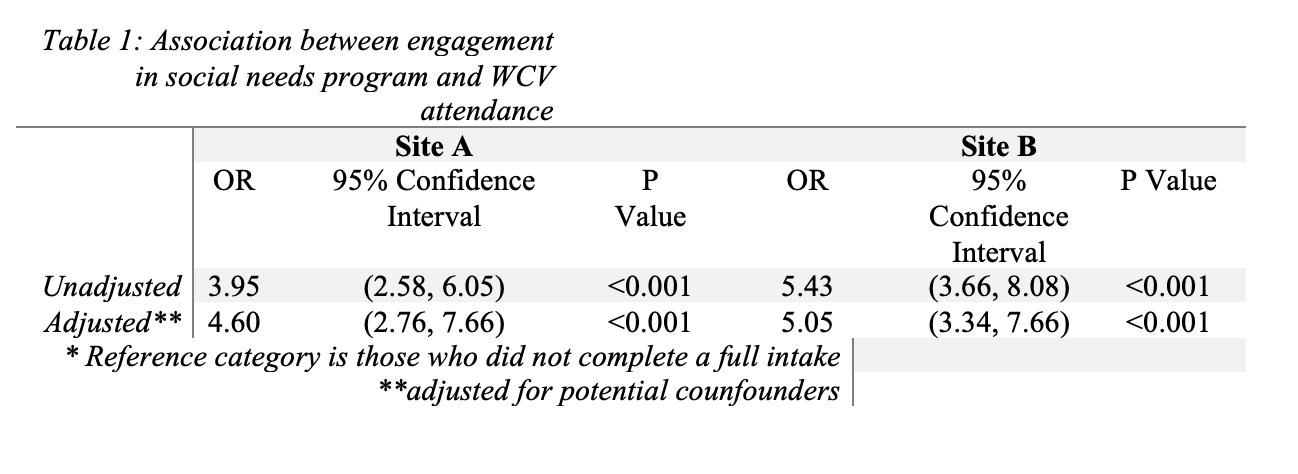Health Equity/Social Determinants of Health
Category: Abstract Submission
Health Equity/Social Determinants of Health III
104 - Engagement in a Social Needs Program and Healthcare Utilization in Pediatric Primary Care
Saturday, April 23, 2022
3:30 PM - 6:00 PM US MT
Poster Number: 104
Publication Number: 104.212
Publication Number: 104.212
Sarah Hill, Johns Hopkins University School of Medicine, Baltimore, MD, United States; Barry S. Solomon, Johns Hopkins University School of Medicine, Baltimore, MD, United States

Sarah Hill
Medical Student
Johns Hopkins University School of Medicine
Baltimore, Maryland, United States
Presenting Author(s)
Background: Evidence for social determinants of health (SDOH) interventions on resource linkage has grown over the past decade. Though social and economic needs predict healthcare utilization, few studies have assessed SDOH interventions on these outcomes, particularly in pediatrics.
Objective: The objective of this study was to examine the association between enrollment in a clinic-based social needs program on subsequent well child visit (WCV) attendance and emergency department (ED) use in two primary care clinics (Sites A and B).
Design/Methods: A retrospective cohort study was conducted of patients in two pediatric primary care clinics referred to a social needs program between June-August 2018. We compared healthcare utilization over the subsequent 12 months for those who completed a full intake and received resource navigation (enrolled) to those referred (not enrolled). Logistic regression was used to assess the association between enrollment with WCV attendance and ED visits.
Results: During the study period, of the 1119 patients referred to the program, 878 were enrolled across the two clinics. At Site A, the majority of patients (91%) self-identified as Hispanic compared to 88% identifying as Non-Hispanic Black at Site B. Each site had a diverse range of requested resource needs, with health insurance, baby supplies, and food being among the most common. At both sites, the majority of enrolled patients had high WCV attendance, defined as completing 75-100% of age-based recommended visits (Site A: 79.7%, Site B: 68.7%). High WCV attendance for non-enrolled patients was significantly lower (Site A: 47.6%, Site B: 29.4%). At both sites, enrolled patients were significantly more likely than patients who did not enrolled with the program to be WCV adherent (Site A: OR: 4.60, P value: 0.00, 95% CI: 2.76-7.66; Site B: OR: 5.43, P value: 0.00, 95% CI: 3.66, 8.08). There were no significant differences in emergency department utilization between the two groups at either clinic.Conclusion(s): We found a strong association between program enrollment and well-child visit attendance in two primary care practices serving distinct patient populations, which differ in race, ethnicity, and primary language. Addressing families’ social needs through resource linkage and navigation can improve well-child visit attendance.
CVmodified resume 21.pdf
Table 1 Association between engagement in social needs program and WCV attendance
Association between engagement in social needs program and WCV attendance
Objective: The objective of this study was to examine the association between enrollment in a clinic-based social needs program on subsequent well child visit (WCV) attendance and emergency department (ED) use in two primary care clinics (Sites A and B).
Design/Methods: A retrospective cohort study was conducted of patients in two pediatric primary care clinics referred to a social needs program between June-August 2018. We compared healthcare utilization over the subsequent 12 months for those who completed a full intake and received resource navigation (enrolled) to those referred (not enrolled). Logistic regression was used to assess the association between enrollment with WCV attendance and ED visits.
Results: During the study period, of the 1119 patients referred to the program, 878 were enrolled across the two clinics. At Site A, the majority of patients (91%) self-identified as Hispanic compared to 88% identifying as Non-Hispanic Black at Site B. Each site had a diverse range of requested resource needs, with health insurance, baby supplies, and food being among the most common. At both sites, the majority of enrolled patients had high WCV attendance, defined as completing 75-100% of age-based recommended visits (Site A: 79.7%, Site B: 68.7%). High WCV attendance for non-enrolled patients was significantly lower (Site A: 47.6%, Site B: 29.4%). At both sites, enrolled patients were significantly more likely than patients who did not enrolled with the program to be WCV adherent (Site A: OR: 4.60, P value: 0.00, 95% CI: 2.76-7.66; Site B: OR: 5.43, P value: 0.00, 95% CI: 3.66, 8.08). There were no significant differences in emergency department utilization between the two groups at either clinic.Conclusion(s): We found a strong association between program enrollment and well-child visit attendance in two primary care practices serving distinct patient populations, which differ in race, ethnicity, and primary language. Addressing families’ social needs through resource linkage and navigation can improve well-child visit attendance.
CVmodified resume 21.pdf
Table 1
 Association between engagement in social needs program and WCV attendance
Association between engagement in social needs program and WCV attendance